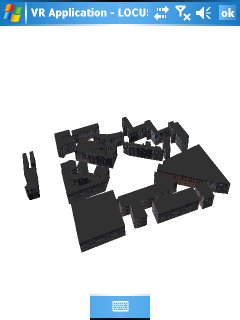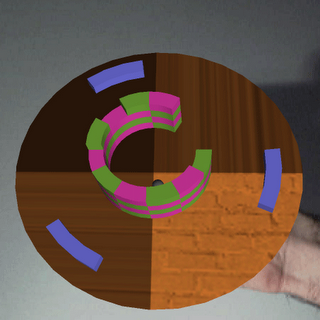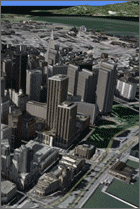
Virtual Reality • Augmented Reality • Human Machine Interaction • Brain Computer Interfaces • Serious Games • Computer Graphics
31 December 2006
MD3DM VR Interface

10 December 2006
LOCUS in Google Earth

More information about Google Earth:
http://earth.google.com
http://www.gearthblog.com
02 December 2006
VR and AR Gaming
The paper first presents the requirements of modern gaming applications and proposes a classification of the most significant game design issues. Next, to realise the issues related to video and virtual reality gaming, an interactive game engine is designed. As a case study a traditional two-dimensional arcade game, called Breakout, is implemented into a virtual environment.
Collision detection is supported between the graphics components of the application based on Newton laws of physics. To test the effectiveness of our approach, a tangible platform for playing interactive three-dimensional games using video see-through augmented reality techniques is proposed.
Moreover, a pilot study evaluated six important issues of each application including: efficiency; usefulness; realism; learning; interaction and camera movement. Initial results illustrated that players preferred the VR Breakout in terms of efficiency and the AR Breakout in terms of game play and ease of interactions. Overall, the AR version seems to have all the necessary potentials to become an alternative platform for future gaming applications.
For more information, a draft version of the article can be downloaded from here.
30 November 2006
Virtual Navigator

As far as the software infrastructure is concerned, Virtual Navigator is designed and implemented for PDAs that make use of the Windows Mobile 5.0 operating system. The graphics functionality is based on VRML technology as it provides the basis for creating mobile and interactive applications. To assist the navigation process, 3D geo-referenced maps are linked with other multimedia content such as 3D text and 3D sound. In addition, the availability of GPRS in the device allows interactive hyperlinks inside the 3D map that provide external navigation information (i.e. link to Google maps). Finally, the GUI is implemented in Microsoft Foundation Classes (MFC) offering the traditional way of windows-based interfaces.
17 November 2006
The LOCUS Project in FT
Title: Mobile telephones offer a new sense of direction
Date: November 17 2006
URL: http://www.ft.com/cms/s/78d609ce-74d2-11db-bc76-0000779e2340.html
Global Positioning System (GPS) phones, which pinpoint a user’s exact location, are the poor relation of the mobile convergence market. While camera phones and internet-enabled devices are increasingly commonplace, the brief flurry of excitement about GPS two or three years ago has died down. The signs are, however, that GPS is in for a resurgence. So what’s been holding it back, and what does the future hold in store for the GPS phone?
GPS, originally developed by the US military and made available for civilian use in the late 1990s, is a network of 28 satellites that broadcast time signals by radio. By comparing the signals from three or four satellites, a GPS receiver can determine its exact position. Until now, the main market for the technology has been businesses, principally in the area of fleet management and, to a lesser extent, in security applications.
While consumer phones with in-built GPS functionality are widely available in Japan, they are still rare in Europe. Three main factors have kept GPS phones out of the shops, says Mike Short, vice-president of research and development at service provider O2 and chairman of the Mobile Data Association (MDA): first, the high cost of designing built-in GPS functionality; second, phone companies have been prioritising other functionality made possible by the introduction of 3G networks, such as video; and third, GPS has had a problem with slow “time-to-fix”, meaning that it can sometimes take a long time for a GPS phone to pinpoint its precise location because tall buildings can block the satellite signal. When Galileo, Europe’s answer to GPS, is launched in 2010, this problem is likely to be reduced because it will double the number of satellites.
In the next two years, we can expect to see the GPS market take off. This quarter also sees the launch, in Europe, of a built-in GPS phone, the Twig Discovery, from Benefon, while Nokia has plans to launch a GPS phone next year. Sony Ericsson, meanwhile, has partnered with GPS provider TomTom, a leader in personal navigation devices. By connecting a wireless receiver to the mobile device, users will be able to access TomTom’s GPS service.
To make GPS a success, manufacturers, application developers and network operators need to work together, says Jonathan Raper, professor of geographic information science at City University: “Location technologies have a very long value chain, right through from satellites to maps on devices and a lot of steps in between.” Prof Raper is a member of the steering committee of Location and Timing Knowledge Transfer Network (LTKTN), a consortium set up by the UK’s Department of Trade and Industry (DTI) that has, he says, been valuable in bringing together UK businesses and academics to research and develop GPS solutions.
What applications can the consumer expect to see on GPS phones? There is no single answer, says Prof Raper: “Whereas the initial attempts to produce applications in this area were rather disappointing, it’s because the mobile operators were looking for a single killer application. But I think, in location, the answer is not one killer application, the answer is 3,000 niche applications.”
Most applications fall into one of two categories: enabling users to work out where they are; or allowing others to locate the user, such as applications to enable parents to keep track of their children, or emergency services to pinpoint the location of an accident.
Benefon’s Twig Discovery will include a voice-based satellite navigation system and two location-based services: Twig Finder, which will enable users to track family and friends who also use the device, with their permission; and Twig Alert, which will enable users to send their exact location to a preset contact list of mobile phone numbers or e-mail addresses at the push of a button – the idea being that in the case of an emergency, one of those contacts will be able to respond.
One likely development in the area of navigation applications, suggests Tunc Yorulmaz, a senior executive in the communications and high-tech practice at Accenture, is the convergence of in-car satellite navigation systems with GPS phones. Drivers will use the device to receive traffic information, and then take it with them when they leave the car to use as a phone and a personal navigation device.
Prof Raper is also looking at the benefits of navigation, and points to the economic cost that arises when people get lost. Among the innovative applications being developed by his team is Locus, a navigation tool that will combine GPS functionality and a digital compass with augmented reality software that mixes virtual information, such as a map, with real-life information about the surrounding environment detected through a camera. The screen displays a 2D or 3D image of the user in their environment, and shows them how to get to their desired destination.
If O2’s Mr Short is right, we can expect to see widespread adoption of GPS phones by 2010. Prof Raper believes the social impact of GPS could be comparable with the introduction of the railways or the telegraph system in the 19th century. “Nobody could quite envisage the transformation of society that would result from these changes,” he says. “We are on the threshold of something quite big.”
For more information about the LOCUS project visit:
http://www.locus.org.uk/
13 November 2006
Blender 3D
11 November 2006
Location-based services for all

The above screenshot illustrates how a user can navigate using the lbs4all software installed on a windows mobile 5.0 PDA. A digital compass is also used (which is inside the rectangular box) to provide orientation information to the user by updating the position on the digital map.
More information:
http://lbs4all.soi.city.ac.uk/
08 November 2006
Virtual Earth 3D
More information:
http://local.live.com/
05 November 2006
The Largest Digital Image

To see the digital image on the web visit:
http://haltadefinizione.deagostini.it/
01 November 2006
Virtual Cities on the Web

As far as the visualisation of the cities is concerned, VRML (Virtual Reality Markup Language) offer the possibilities to interact with three-dimensional information and navigate inside virtual environments. VRML works as a plug-in on web browsers and it is free of download.
A list of some examples of virtual cities that are free to navigate is provided below:
Virtual City (UK)
http://www.locus.org.uk/Virtual%20City/virtual_city.html
Virtual London (UK)
http://www.casa.ucl.ac.uk/projects/projectDetail.asp?ID=55
Virtual Medieval Castles (UK)
http://www.timeref.com/3dindex.htm
VRGlasgow (Scotland)
http://www.vrglasgow.co.uk/
Virtual St. Pierre church (France)
http://christler.cedric.free.fr/stpierre/
Virtual Toronto (Kanada)
http://www.intoronto.com/
Virtual Xanthi (Greece)
http://www.67100.gr/
Virtual Ljubljana (Slovenia)
http://www.ljubljana.si/en/ljubljana/virtual_ljubljana/default.html
22 October 2006
Wii Controller
The wireless Wii Remote controller which has the size of a traditional remote control is a multifunctional device that is limited only by the game designer's imagination. It uses Bluetooth technology to send user's actions to the Wii console from as far as 30 feet away. As a pointing device, the controller can send a signal from as far as 15 feet away. Up to four Wii Remote Controllers can be connected at once, allowing for multiplayer capabilities.
In addition to its pointing and motion-sensing abilities, the Wii Remote controller also includes a speaker, rumble feature and expansion port for additional input devices, such as the Nunchuk controller.
For example, in a tennis game, the wireless Wii Remote controller can serve as your racket you swing with your arm. In a driving game, it serves as your steering wheel. For first-person shooters, the remote acts as your weapon that you point at an enemy.
More information:
http://wii.nintendo.com/controllers.html
http://uk.wii.com/exp/
12 October 2006
10megapixel cameraphone
More information:
http://www.samsung.com/PressCenter/PressRelease/PressRelease.asp?seq=20060309_0000239138
04 October 2006
Nobel Foundation
The Nobel prize announcements for this year have been finalised for Medicine, Physics and Chemistry and we are still awaiting for the rest awards.
More information:
http://nobelprize.org/
24 September 2006
TorPark - mobile anonymous browsing
When a user logs onto the internet then a unique IP address is assigned to manage the computer's identity. Each website the user visits, the user's IP address gets stored. The Torpark program works by routing Internet traffic through several servers, obscuring the originating address. The Tor network causes the IP address seen by the website to change every few minutes to mask the requesting source.Some examples of where Torpark can be used include bypassing paying for internet access at a wifi café or at school computers so you can get full access to the internet.
Download Torpark:
http://torpark.nfshost.com/
Sources:
http://www.vnunet.com/vnunet/news/2164698/hackers-fire-anonymous-torpark
http://en.wikipedia.org/wiki/Torpark
http://www.boingboing.net/2006/05/09/torpark_anonymizing_.html
16 September 2006
Fourth-generation (4G) and VR
Title: Fast Forward to 4G?
Date: 13th April, 2004
URL: http://www.4g.co.uk/PR2004/April2004/2018.htm
US Network Magazine : Here's something we don't see often: a wireless technology that could actually arrive earlier than predicted. Fourth-generation (4G) cellular services, intended to provide mobile data at rates of 100Mbits/sec or more, were originally scheduled for 2010. Some cell phone companies have moved the target up to 2006, while rival wireless systems could bring similar bandwidth to a few fortunate networkers a lot sooner.
Alas, the enthusiasm for 4G isn't due to accelerated progress; it's because third-generation (3G) services have proven so disappointing. Instead of one standard worldwide, there are three incompatible systems in the United States alone. Voice is carried over the circuit-switched infrastructure inherited from second-generation (2G), not the promised IP. The touted streaming video is just a low-resolution slideshow. Most importantly, the data rates are closer to dial up than DSL.
This is partially due to the technology's immaturity: 3G systems rolled out so far could be considered beta versions, with the real thing still in the future. But 3G will never live up to its creators' promises. Despite early excitement about data, the main economic incentive for 3G is increased capacity for narrowband voice. Though data rates will increase, there isn't enough bandwidth to transfer large e-mail attachments quickly, let alone stream audio or video at broadcast quality as the cell phone vendors first claimed.
If you believe the industry, 4G will enable all this and more: Many companies talk of holophones, remote-controlled cars, and mobile virtual reality. Given their past record of hype, there are good reasons not to believe the more outlandish predictions, but there are also reasons to think that some aspects of 4G could be real.
According to the Fourth-Generation Mobile Forum (www.4gmobile.com), companies will have invested more than $30 billion in 4G by the end of 2002. And unlike previous generations, 4G won't be a product of the cellular industry alone. While the most advanced plans have come from Japanese and European mobile operators, fixed wireless carriers in the United States are beating a separate path to mobility. Most exciting, new types of wireless LAN technology already offer speeds approaching those of 4G.
Read more
Relative Links
4G Mobile Via Stratellite
In addition to the Company's National Wireless Broadband Network, proposed telecommunications uses include cellular, 3G/4G mobile.
4G Mobile PC Capabilities
3G and 4G Mobile operators have demanded products that will offer PC capabilities in a PDA form factor. Miniaturized or folding keyboards are not fully functional or portable.
OFDM Technology and (4G) Cellular Systems
Practical confirmation that the OFDM technology being supported by the WiMAX Forum(1) is a contender for future fourth generation (4G) cellular systems.
DoCoMo's 4G Reseach
It may not be the Central Intelligence Agency, but NTT DoCoMo also operates its research and development center as if it were a top-secret facility.
802.16 Application at 4G Speeds
Engineers are currently developing an 802.16 application that will provide next generation (4G) high-speed Internet services from the SatCell IP base station.
4G Wireless Letter Of Intent
The LOI calls for Mitec to supply a range of RF products and subsystems for fourth generation (4G) broadband data networks.
4G Wireless Trial
Participants in the trial will include employees from select Nextel enterprise customers, including Cisco Systems. . They will be able to take full advantage of average downlink speeds of up to 1.5 megabits per second.
4GEN Mobile Broadband Wireless
4G mobile broadband wireless system provides data, video, audio, and voice services to subscribers on the move, at highway speeds.
4G Wireless Causing A Buzz
The year being targeted for a 4G trial to kick off in the Far East is 2007. Why 4G ? What can 4G do and why.
12 September 2006
PRAM
PRAM features the fast processing speed of RAM for its operating functions combined with the non-volatile features of flash memory for storage, giving it the nickname: perfect RAM. Moreover, PRAM can rewrite data without having to first erase data previously accumulated, it is effectively 30-times faster than conventional flash memory. Incredibly durable, PRAM is also expected to have at least 10-times the life span of flash memory.
PRAM will be a highly competitive choice over NOR flash but will be available commercially in 2008. Samsung designed the cell size of its PRAM to be only half the size of NOR flash. Furthermore, it requires 20 percent fewer process steps to produce than those used in the manufacturing of NOR flash memory.
PRAM was developed by adopting the use of vertical diodes with the three–dimensional transistor structure that it now uses to produce DRAM. The new PRAM has the smallest 0.0467um 2 cell size of any working memory that is free of inter-cell noise, allowing virtually unlimited scalability.
Adoption of PRAM is expected to be especially popular in the future designs of multi-function handsets and for other mobile applications, where faster speeds translate into immediately noticeable boosts in performance. High-density versions will be produced first, starting with 512 Mb.
For more details the full article can be found in:
http://www.samsung.com/PressCenter/PressRelease/PressRelease.asp?seq=20060911_0000286481
11 September 2006
University Guide 2006
http://www.timesonline.co.uk/section/0,,8403,00.html
The assessment contains of useful information for academics, researchers and students such as league tables (including research and teaching) as well brief summaries of university profiles.
10 September 2006
Welcome
From time to time, I will post my personal opinion about research issues which I find interesting and challenging. Some of them will be related to my research interests including computer graphics and visualisation, virtual and augmented reality, human computer interaction, interactive applications, mobile applications, tangible interfaces, information science and educational and learning systems.
This blog will also host views and ideas covering anything else that is related to the broader field of science and in particular computer science.
I hope that the discussions will be exciting.

